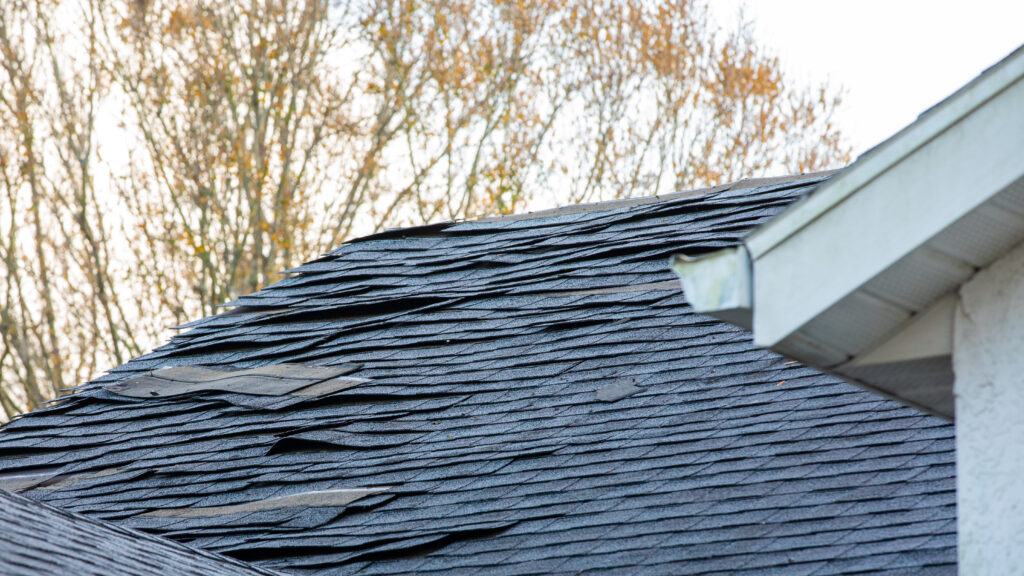The thunder’s deafening rumbles have quieted, the wind’s fierce gusts have settled, and the rain’s relentless pour has dwindled to mere droplets. Pulling back the blinds, the sight of a yard in disarray meets your gaze. A pressing thought emerges, “Did my home endure? What’s our next move?”
If you’ve lived even a few seasons in the Gulf states, you’ve likely experienced the strong and sometimes unpredictable weather that is one defining characteristic of our region. From powerful thunderstorms that produce damaging winds, devastating tornadoes and hail to tropical storms and hurricanes that threaten coastal and inland areas from June until the end of November, the Gulf Coast is no stranger to extreme weather.
If you’ve been affected by a storm and your home has experienced roof storm damage, it’s important that you address any issues promptly. Doing so can help you protect your home from further harm and your family from potential health risks like mold growth that could develop. By making timely repairs, you can ensure compliance with insurance requirements while preventing the development of more extensive issues.
Our comprehensive guide on handling roof storm damage provides you with the essential steps you’ll need to take if you’ve been affected by a storm and are trying to determine what’s next. While we’ll never be able to control the storm, we are in control of our response. By following the recommendations outlined below, you’ll be able to effectively navigate the repair process, from identifying and assessing storm damage to understanding and filing your insurance claim to successfully completing the restoration process.
Identifying the Signs of Roof Storm Damage
The first step in handling roof storm damage is to look for common signs indicating the type and extent of issues your roof has sustained. The table below outlines common issues to look out for during your inspection.
| Common Signs of Roof Storm Damage | ||
|---|---|---|
| Common Signs of Roof Storm Damage | ||
| Missing or Damaged Shingles | Check for shingles that are torn, curled, cracked, or completely missing. These vulnerabilities can allow water to penetrate your roof. | |
| Water Leaks or Stains | Inspect your ceilings, walls, and attic for water stains, dampness, or any signs of water intrusion. Even minor stains can indicate a hidden roof problem. | |
| Dents or Cracks | Examine roofing materials for dents, cracks, or pockmarks, especially if your area experienced hail during the storm. | |
| Damaged Gutters and Downspouts | Look for dented or detached gutters and downspouts. They can be indicators of an impact of debris or hail on your roof. | |
| Fallen Debris | Inspect your roof for fallen branches, leaves, or other debris from the storm. This debris can cause damage or block drainage systems. | |
| Granule Loss | Check for an excess of granules from asphalt shingles in your gutters or on the ground. Granule loss can signify shingle damage. | |
| Interior Issues | Pay attention to signs of damage inside your home, such as peeling paint or wallpaper, sagging ceilings, or increased indoor humidity levels. | |
| Altered Roofline | Visually assess your roof's contour. Any noticeable sagging or irregularities may indicate structural damage. | |
| Unusual Sounds | Listen for unusual noises, like creaking or popping, which could signal roof stress or damage. | |
| Attic Issues | Examine your attic after a storm for signs of daylight coming through the roof, as well as moisture or water stains. | |
If you notice any of the issues described above during your inspection, you’ll want to take action and properly assess and address the damage. Delaying repairs can lead to more extensive and costly fixes in the long run. In the next section, we’ll dig deeper into how to document any damages you’ve found.
Documenting the Damage
Once you’ve identified potential signs of roof storm damage, the next crucial step is to document your findings. Here’s a systematic approach that you can use as a guide:
- Collect Visual Documentation: As you inspect your roof and attic, take clear and detailed photographs of the damage. These images serve as essential evidence when dealing with insurance claims and working with roofing contractors. Ensure the photos capture the full extent of the damage, including close-ups of affected areas.
- Note Key Details: Alongside your photographs, make notes about the damage. Include details such as the location and size of the damaged areas, the type of roofing materials affected, and any structural issues you notice. This information not only aids in the assessment but also helps you provide accurate information when seeking estimates or filing insurance claims.
- Include Date and Time: Record the date and time of your inspection. This timestamp can be valuable for establishing when the damage occurred, especially if you are filing an insurance claim.
- Consider a Professional Assessment: If you hire a roofing contractor for a professional assessment, request a written report that outlines their findings and recommendations. This report can be a critical document in the claims process and can help you make informed decisions about repairs or replacements.

By clearly documenting any damage you identify, you can streamline the process of filing an insurance claim and repairing your roof. Next, let’s take a closer look at the insurance process because it will be an important part of the restoration.
The Insurance Claims Process in Three Steps
When dealing with roof storm damage, efficiently navigating the insurance claims process is imperative. Below, we’ve outlined the key steps you’ll need to follow to expedite the process.
1. Contact Your Insurance Company
First things first—promptly notify your insurance company of the roof storm damage. Initiate the claims process and request a copy of your policy if needed.
2. Schedule an Adjuster Visit
Your insurer will assign an adjuster to your claim to assess the damage. Coordinate a convenient time for them to visit and provide them with your documented findings, including photographs, notes, and any professional assessments you gathered when you initially identified the signs of storm damage.
3. File Your Claim
When filing your claim, be sure to include critical details that will help expedite your claim and get you closer to restoration. Most claims will require some or all of the following details:
- Your policy information and number
- Date and location of the storm
- Comprehensive documentation of the damage
- Estimates from roofing contractors
Submit your insurance claim promptly to ensure you comply with any deadlines outlined in your policy for storm damage claims. It’s safe to say, “the sooner, the better,” when working with insurance companies and submitting claims for repairs and replacements.
Partnering With a Trusted Roofing Contractor
Once you’ve filed your claim and it’s been reviewed and approved by your insurance company, the restoration process can begin. Throughout the restoration work, be sure to keep communication lines open with both your contractor and the insurance company. When determining the best roofing contractor for the job, you’ll want to ensure they are licensed, insured, and highly experienced in roof storm damage restoration. By partnering with an experienced and professional team, you can ensure that the work aligns with the insurance-approved estimate and avoid any potential issues that could otherwise arise.
Roof storm damage is never something that we want to occur. If it does, though, it’s good to know that roofing professionals are available to help return your home to its pre-damaged condition, making it once again safe and sound for you and your family.
Gulf States Roofing and Construction brings over 50 years of experience to post-storm roofing solutions, helping communities rebuild homes and restore hope in areas that have experienced natural disasters. Contact our response team today to learn more about how we repair roof storm damage while keeping you informed and comfortable every step of the way.






